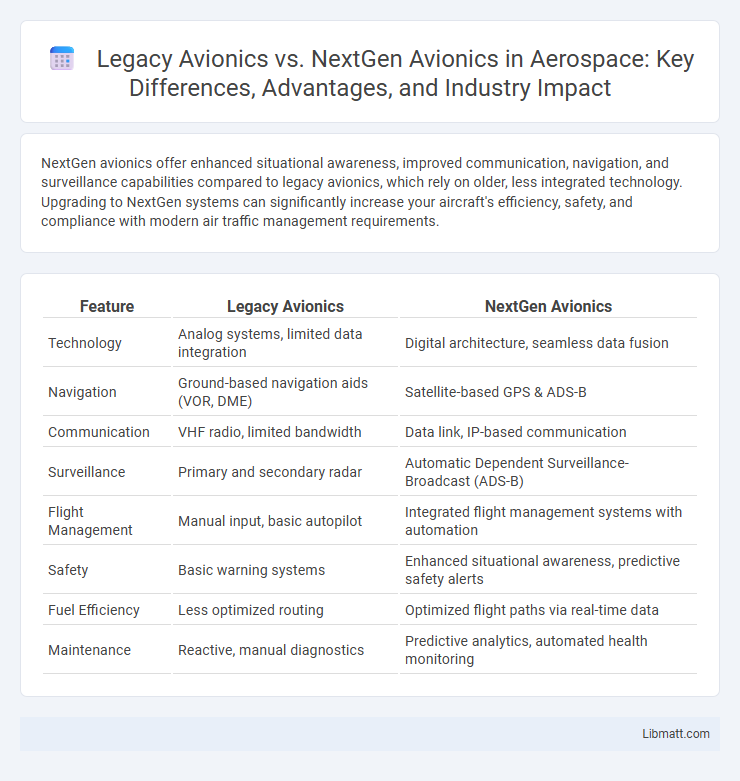NextGen avionics offer enhanced situational awareness, improved communication, navigation, and surveillance capabilities compared to legacy avionics, which rely on older, less integrated technology. Upgrading to NextGen systems can significantly increase your aircraft's efficiency, safety, and compliance with modern air traffic management requirements.
Table of Comparison
| Feature | Legacy Avionics | NextGen Avionics |
|---|---|---|
| Technology | Analog systems, limited data integration | Digital architecture, seamless data fusion |
| Navigation | Ground-based navigation aids (VOR, DME) | Satellite-based GPS & ADS-B |
| Communication | VHF radio, limited bandwidth | Data link, IP-based communication |
| Surveillance | Primary and secondary radar | Automatic Dependent Surveillance-Broadcast (ADS-B) |
| Flight Management | Manual input, basic autopilot | Integrated flight management systems with automation |
| Safety | Basic warning systems | Enhanced situational awareness, predictive safety alerts |
| Fuel Efficiency | Less optimized routing | Optimized flight paths via real-time data |
| Maintenance | Reactive, manual diagnostics | Predictive analytics, automated health monitoring |
Overview of Legacy and NextGen Avionics
Legacy avionics primarily rely on analog systems, offering basic navigation, communication, and surveillance capabilities with limited integration. NextGen avionics introduce digital avionics architecture, incorporating satellite-based navigation (such as GPS and ADS-B), enhanced data link communications, and real-time traffic management systems. These advancements enable improved situational awareness, fuel efficiency, and airspace capacity compared to traditional legacy systems.
Technological Evolution in Avionics Systems
Legacy avionics systems rely on analog instruments and limited data processing capabilities, often restricting real-time communication and navigation accuracy. NextGen avionics incorporate advanced digital technology, including satellite-based GPS, data link systems, and integrated flight management systems that enhance situational awareness and optimize flight efficiency. This technological evolution improves air traffic management, reduces pilot workload, and increases overall flight safety.
Key Features of Legacy Avionics
Legacy avionics systems primarily rely on analog instruments and radar-based navigation with limited automation, requiring manual input and constant pilot monitoring. These systems use traditional communication frequencies and lack the real-time data exchange capabilities found in modern aircraft technology. Maintenance and upgrades can be costly and time-consuming due to outdated hardware and software compatibility issues.
Advancements Offered by NextGen Avionics
NextGen avionics offer significant advancements over legacy systems by integrating satellite-based navigation, improving flight accuracy and safety through real-time data exchange. Enhanced situational awareness is achieved via advanced digital displays and automated systems, reducing pilot workload and increasing operational efficiency. Your flight operations benefit from optimized air traffic management, leading to fuel savings, reduced emissions, and improved on-time arrivals.
Performance and Reliability Comparison
Legacy avionics systems rely on older technology with limited processing capabilities, often resulting in slower data updates and less precise navigation. NextGen avionics leverage advanced satellite-based systems and real-time data integration, significantly improving performance accuracy and communication reliability. Upgrading to NextGen avionics enhances Your flight efficiency and safety by reducing delays and increasing situational awareness.
Impact on Flight Safety and Efficiency
NextGen avionics significantly enhance flight safety by incorporating advanced technologies such as ADS-B, which provides real-time aircraft position data, reducing collision risks compared to legacy systems reliant on radar-based surveillance. Efficiency is improved through optimized flight paths enabled by satellite-based navigation and communication, decreasing fuel consumption and lowering delays in congested airspace. The transition from legacy avionics to NextGen also supports better weather awareness and automated alerting systems, contributing to safer and more predictable flight operations.
Integration and Compatibility Challenges
Legacy avionics systems often face significant integration challenges due to outdated hardware and software architectures that lack compatibility with modern digital communication protocols. NextGen avionics prioritize seamless interoperability by utilizing standardized interfaces and modular designs, enabling easier integration with current and future air traffic management technologies. This enhanced compatibility reduces maintenance complexity and supports advanced functionalities like real-time data sharing and improved situational awareness.
Cost Implications and Investment Considerations
Legacy avionics systems typically incur higher maintenance costs due to outdated technology and limited compatibility with modern air traffic management systems, leading to increased operational expenses over time. NextGen avionics require significant upfront investment in advanced hardware and software integration but offer long-term savings through improved fuel efficiency, enhanced situational awareness, and compliance with evolving regulatory standards. Evaluating cost implications involves balancing initial capital expenditures against reduced downtime, lower maintenance needs, and potential operational efficiencies offered by NextGen technology.
Regulatory Compliance and Certification
Legacy avionics systems adhere to older regulatory standards such as DO-178B and DO-254, often requiring extensive recertification processes when modifications occur. NextGen avionics incorporate advanced technologies that comply with updated regulations, including DO-178C and DO-254 revisions, facilitating faster certification timelines and enhanced interoperability. The FAA and EASA promote NextGen avionics certification frameworks that emphasize software assurance, cybersecurity, and real-time data handling to meet evolving safety and performance mandates.
Future Trends in Avionics Development
NextGen avionics are rapidly advancing with enhanced data integration, satellite-based navigation, and real-time communication systems, surpassing the limitations of legacy avionics that rely on older analog and less efficient technologies. Future trends emphasize artificial intelligence for predictive maintenance, increased automation for improved safety, and augmented reality interfaces to assist pilot situational awareness. Your aviation operations will benefit from adopting these innovations, ensuring compliance with evolving regulations and improving overall flight efficiency.
Legacy avionics vs NextGen avionics Infographic

 libmatt.com
libmatt.com